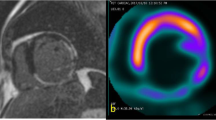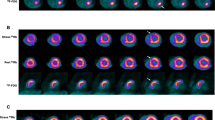Abstract
201Tl and18F-FDG are useful for acute myocardial infarction (MI) assessment. The goal of this study was to compare their predictive value for wall motion recovery in the culprit area after a recent reperfused MI using SPECT technique.
Methods
Forty-one patients (mean age: 56±12 years) were included, 81% of them male; all were studied within 1–24 days post MI. They underwent angioplasty in 27 cases (12 primary); bypass grafting in 10 cases and successful thrombolysis in 4. SPECT201Tl injected at rest and redistribution (R-R) and also18F-FDG, were performed on different days. Processed tomograms were interpreted blinded to clinical or angiographic data. Segmental wall motion assessed with echocardiography at baseline was compared with the 3 month follow up.
Results
Sensitivity [Confidence Interval] for201Tl R-R was 74.6% [60.5–84.5], for FDG it was 82.1% [70.8–90.4]; specificities were 73% [64.3–80.5] and 54.8% [45.6–63.7], respectively.18F-FDG tended to be more sensitive than 201Tl R-R, but the latter was more specific (p < 0.0004). Both201T1 R-R and18F-FDG presented high negative predictive value (p: ns).Conclusion: In recent MI, SPECT201Tl R-R is a valuable and widely available technique for viability detection, with similar sensitivity and significant better specificity than SPECT18F-FDG.
Similar content being viewed by others
References
Bax JJ, Wijns W, Cornel JH, Visser FC, Boersma E, Fioretti PM. Accuracy of currently available techniques for prediction of functional recovery after revascularization in patients with left ventricular dysfunction due to chronic coronary artery disease: Comparison of pooled data.J Am Coll Cardiol 1997; 30:1451–1460.
Bax JJ, Cornel JH, Visser FC, et al. Prediction of recovery of myocardial dysfunction after revascularization. Comparison of fluorine-18 fluorodeoxyglucose/thallium-201 SPECT, thallium-201 stress-reinjection SPECT and dobutamine echocardiography.J Am Coll Cardiol 1996; 28:558–564.
Spinelli L, Petretta M, Cuocolo A, et al. Prediction of recovery of left ventricular dysfunction after acute myocardial infarction: Comparison between99mTc-sestamibi cardiac tomography and low-dose dobutamine echocardiography.J Nucl Med 1999; 40:1683–1692.
Opie LH, Hesse B. Radionuclide tracers in the evaluation of resting myocardial ischaemia and viability.Eur J Nucl Med 1999; 24:1183–1193.
Braunwald E, Kloner RA. The stunned myocardium: Prolonged postischemic ventricular dysfunction.Circulation 1982; 66:1146–1149.
Jennings RB. Early phase of myocardial ischemic injury and infarction.Am J Cardiol 1969; 24:753–765.
Beanlands RS, Labinaz M, Ruddy TD, et al. Establishing an approach for patients with recent coronary occlusion: Identification of viable myocardium.J Nucl Cardiol 1999; 6:298–305.
Schwaiger M, Brunken R, Grover-McKay M, et al. Regional myocardial metabolism in patients with acute myocardial infarction assessed by positron emission tomography.J Am Coll Cardiol 1986; 8:800–804.
Di Carli MF, Asgarzadie F, Scheiben HR, Brunken RC, Rokhsar S, Maddahi J. Relation of myocardial perfusion at rest and during pharmacological stress to the PET patterns of tissue viability in patients with severe left ventricular dysfunction.J Nucl Cardiol 1998; 5:558–566.
Burt RW, Perkins OW, Oppenheim BE, et al. Comparison of F-18 FDG SPECT, F-18 FDG PET and rest thallium 201 SPECT for detection of myocardial viability.J Nucl Med 1995; 36:176–179.
Bax JJ, Patton JA, Poldermans D, et al. 18-Fluorodeoxy- glucose imaging with positron emission tomography and single photon emission computed tomography: cardiac applications.Semin Nucl Med 2000; 30:281–298.
Bax JJ, Visser FC, Blanksma PK, et al. Comparison of myocardial uptake of fluorine-18-fluorodeoxyglucose imaged with PET and SPECT in dyssynergic myocardium.J Nucl Med 1996; 37:1631–1636.
Port SC. Imaging guidelines for nuclear cardiology procedures. Part 2.J Nucl Cardiol 1999; 6:G47-G84.
Schiller NB, Shah PM, Crawford M, et al. Recommendations for quantitation of the left ventricle by two-dimensional echocardiography. American Society of Echocardiography Committee on Standards, Subcommittee on Quantitation of Two-Dimensional Echocardiograms.J Am Soc Echocardiogr 1989; 2:358–367.
Bax J, Maddahi J, Poldermans D, et al. Preoperative comparison of different non invasive strategies for predicting improvement in left ventricular function after coronary artery by-pass grafting.Am J Cardiol 2003; 92:1–4.
Dangas G, Machac J, Goldman ME, et al. Evaluation of myocardial viability in asymptomatic patients early after infarction with perfusion/metabolism single-photon-emission computed tomographic imaging and dobutamine echocardiography.Coron Artery Dis 2000; 11:409–414.
Czernin J, Porenta G, Brunken R, et al. Regional blood flow, oxidative metabolism, and glucose utilization in patients with recent myocardial infarction.Circulation 1993; 88:884–895.
Udelson JE, Coleman PS, Metherall J. Predicting recovery of severe regional ventricular dysfunction. Comparison of resting scintigraphy with201Thallium and99mTc-sestamibi.Circulation 1994; 89:2552–2561.
Sciagra R, Pellegri M, Pupi A, et al. Prognostic implications of Tc-99m sestamibi viability imaging and subsequent therapeutic strategy in patients with chronic coronary artery disease and left ventricular dysfunction.J Am Coll Cardiol 2000; 36:739–745.
Bonow RO, Dilsizian V, Cuocolo A, Bacharach SL. Identification of viable myocardium in patients with chronic coronary artery disease on left ventricular dysfunction. Comparison of thallium scintigraphy with reinjection and PET imaging with18F-fluorodeoxyglucose.Circulation 1991; 83:26–37.
Beller G, Zaret B. Contributions of nuclear cardiology to diagnosis and prognosis of patient with coronary artery disease.Circulation 2000; 101:1465–1478.
Nagueh S, Vaduganathan P, Ali N, et al. Identification of hibernating myocardium: Comparative accuracy of myocardial contrast echocardiography, rest-redistribution thallium 201 tomography and dobutamine echocardiography.J Am Coll Cardiol 1997; 29:985–993.
Pierard L, De Landsheere C, Berthe C, Rigo P, Kulbertus H. Identification of viable myocardium by echocardiography during dobutamine infusion in patients with myocardial infarction after thrombolytic therapy: Comparison with positron emission tomography.J Am Coll Cardiol 1990; 15:1021–1031.
DePuey EG, Ghesani M, Schwartz M, Friedman M, Nichols K, Salensky H. Comparative performance of gated perfusion SPECT wall thickening, delayed thallium uptake, and F-18 fluorodeoxyglucose SPECT in detecting myocardial viability.J Nucl Cardiol 1999; 6:418–428.
Marwick TH, Maclntyre WJ, Lafont A, et al. Metabolic responses of hibernating and infarcted myocardium to revascularization. A follow-up study of regional perfusion, function, and metabolism.Circulation 1992; 85:1347- 1353.
Cornel JH, Bax JJ, Elhendy A, et al. Agreement and disagreement between “metabolic viability” and “contractile reserve” in akinetic myocardium.J Nucl Cardiol 1999; 6:383–388.
Califf RM, Fortin DF, Frid DJ, et al. Restenosis after coronary angioplasty: an overview.J Am Coll Cardiol 1991; 17:2B-13B.
Faxon D, Kelsey SF, Ryan TJ, McCabe CH, Detre K. Determinants of successful percutaneous transluminal coronary angioplasty: report from the National Heart, Lung and Blood Institute registry.Am Heart J 1984; 108:1019- 1023.
DiSciascio G, Vetrovec GW, Cowley MJ, Wolfgang TC. Early and late outcomes of percutaneous transluminal coronary angioplasty for subacute and chronic total coronary occlusion.Am Heart J 1986; 111:833–839.
Fragasso G, Chierchia SL, Lucignani G, et al. Time dependence of residual tissue viability after myocardial infarction assessed by [18F]fluorodeoxyglucose and positron emission tomography.Am J Cardiol 1993; 72:131G-139G.
Ragosta M, Powers ER, Samady H, Gimple LW, Sarembock IJ, Beller GA. Relationship between extent of residual myocardial viability and coronary flow reserve in patients with recent myocardial infarction.Am Heart J 2001; 141:456–462.
Uren NG, Crake T, Lefroy DC, de Silva R, Davies GJ, Maseri A. Reduced coronary vasodilator function in infarcted and normal myocardium after myocardial infarction.N Engl J Med 1994; 331:222–227.
Yamagishi H, Akioka K, Hirata K, et al. A Reverse Flow- Metabolism Mismatch Pattern on PET Is Related to Multivessel Disease in Patients with Acute Myocardial Infarction.J Nucl Med 1999; 40:1492–1498.
Perrone-Filardi P, Pace L, Prastaro M, et al. Assessment of Myocardial Viability in Patients with Chronic Coronary Artery Disease. Rest-4-Hour-24-Hour201Tl Tomography Versus Dobutamine Echocardiography.Circulation 1996; 94:2712–2719.
Yamagishi H, Akioka K, Hirata K, et al. A reverse flow- metabolism mismatch pattern: a new marker of viable myocardium with greater contractility during dobutamine stress than myocardium with a flow-metabolism mismatch pattern.Jpn Circ J 2000; 64:659–666.
González P, Massardo T, Coll C, et al. An assessment of wall motion, perfusion and glucose metabolism in recent myocardial infarction: a comparison in patients with and without revascularization.Nucl Med Commun 2003; 24:1155–1165.
Kam BL, Valkema R, Poldermans D, et al. Feasibility and image quality of dual-isotope SPECT using18F-FDG and99mTc-tetrofosmin after acipimox administration.J Nucl Med 2003; 44:140–145.
Bax JJ, Visser FC, Poldermans D, et al. Safety and feasibility of cardiac FDG SPECT following oral administration of Acipimox, a nicotinic acid derivative: Comparison of image quality with hyperinsulinemic euglycemic clamping in nondiabetic patients.J Nucl Cardiol 2002; 9:587–593.
Schroder O, Hor G, Hertel A, Baum RP. Combined hyperinsulinaemic glucose clamp and oral acipimox for optimizing metabolic conditions during18F-fluorodeoxy- glucose gated PET cardiac imaging: comparative results.Nucl Med Commun 1998; 19:867–874.
Knuuti MJ, Yki-Jarvinen H, Voipio-Pulkki LM, et al. Enhancement of myocardial [fluorine-18]fluorodeoxy-glucose uptake by a nicotinic acid derivative.J Nucl Med 1994; 35:989–998.
Elhendy A, Trocino G, Salustri A, et al. Low-dose dobutamine echocardiography and rest-redistribution thallium- 201 tomography in the assessment of spontaneous recovery of left ventricular function after recent myocardial infarction.Am Heart J 1996; 131:1088–1096.
Sciagra R, Bolognese L, Rovai D, et al. Detecting myocardial salvage after primary PTCA: early myocardial contrast echocardiography versus delayed sestamibi perfusion imaging.J Nucl Med 1999; 40:363–370.
Smart S, Stoiber T, Hellman R, et al. Low dose dobutamine echocardiography is more predictive of reversible dysfunction after acute myocardial infarction than resting single photon emission computed tomographic thallium-201 scintigraphy.Am Heart J 1997; 134:822–834.
Anselmi M, Golia G, Maines M, et al. Comparison between low-dose dobutamine echocardiography and thallium-201 scintigraphy in the detection of myocardial viability in patients with recent myocardial infarction.Int J Cardiol 2000; 31:213–223.
Hillis GS, Mulvagh SL, Pellikka PA, et al. Comparison of intravenous myocardial contrast echocardiography and low- dose dobutamine echocardiography for predicting left ventricular functional recovery following acute myocardial infarction.Am J Cardiol 2003; 92:504–508.
Author information
Authors and Affiliations
Corresponding author
Rights and permissions
About this article
Cite this article
González, P., Massardo, T., Coll, C. et al. The predictive value of201Tl rest-redistribution and18F-fluorodeoxyglucose SPECT for wall motion recovery after recent reperfused myocardial infarction. Ann Nucl Med 18, 97–103 (2004). https://doi.org/10.1007/BF02985099
Received:
Accepted:
Issue Date:
DOI: https://doi.org/10.1007/BF02985099




